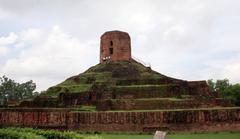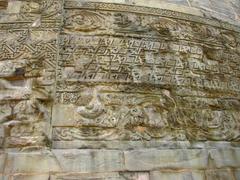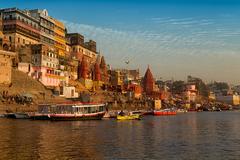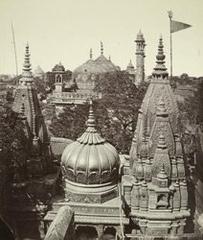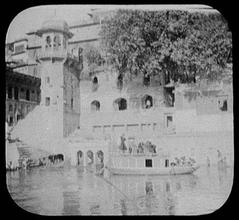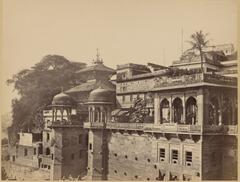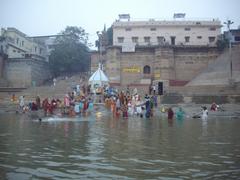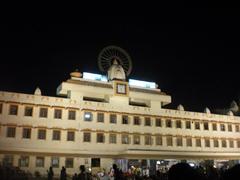Visiting Tulsi Ghat Varanasi: History, Tickets, and Tips
Date: 18/08/2024
Introduction
Tulsi Ghat, situated on the sacred banks of the Ganges River in Varanasi, India, is a landmark steeped in historical, cultural, and spiritual significance. Named after the 16th-century poet-saint Tulsidas, celebrated for composing the epic ‘Ramcharitmanas,’ this ghat is more than just a spot for ritual bathing. It serves as a vibrant center for various religious ceremonies, cultural events, and daily life activities, drawing pilgrims, scholars, and tourists from all corners of the world (Lonely Planet).
Tulsi Ghat features prominently in the tapestry of Varanasi’s spiritual and cultural identity. Open 24/7 and free to visit, the ghat offers a serene and captivating experience, particularly during the early morning or late evening when the ambiance is imbued with a sense of tranquility and reverence (Optimatravels). The ghat is also a focal point for several festivals, religious rituals, and cultural performances, making it a must-visit for anyone keen on experiencing the essence of Varanasi (Culture and Heritage).
This comprehensive guide aims to cover all aspects of visiting Tulsi Ghat, from its historical origins and architectural developments to its cultural significance and environmental challenges. Whether you are planning a pilgrimage, a cultural expedition, or simply a leisurely visit, this guide will equip you with all the essential information to make the most of your trip.
Table of Contents
- [Introduction](#introductionintroduction)
- [Visiting Hours](#visiting-hoursvisiting-hours)
- [Ticket Information](#ticket-informationticket-information)
- [Travel Tips](#travel-tipstravel-tips)
- [Historical Significance](#historical-significancehistorical-significance)
- [Origins and Naming](#origins-and-namingorigins-and-naming)
- [Tulsidas and His Works](#tulsidas-and-his-workstulsidas-and-his-works)
- [Architectural Developments](#architectural-developmentsarchitectural-developments)
- [Religious and Cultural Activities](#religious-and-cultural-activitiesreligious-and-cultural-activities)
- [Legends and Myths](#legends-and-mythslegends-and-myths)
- [Environmental and Social Impact](#environmental-and-social-impactenvironmental-and-social-impact)
- [Economic Contributions](#economic-contributionseconomic-contributions)
- [Notable Incidents](#notable-incidentsnotable-incidents)
- [Associated Temples and Structures](#associated-temples-and-structuresassociated-temples-and-structures)
- [Cultural Programs and Festivals](#cultural-programs-and-festivalscultural-programs-and-festivals)
- [Conclusion](#conclusionconclusion)
- [Sources](#sourcessources)
Visiting Hours
Tulsi Ghat is accessible 24/7, but the best time to visit is during the early morning or late evening to experience the serene and spiritual ambiance.
Ticket Information
There is no entry fee for visiting Tulsi Ghat. However, donations are welcomed at the temples located on the ghat.
Travel Tips
- Best Time to Visit: Early mornings or late evenings.
- Nearby Attractions: Kashi Vishwanath Temple, Assi Ghat, Dashashwamedh Ghat.
- Accessibility: The ghat has stone steps leading to the river, which might be challenging for individuals with mobility issues.
Historical Significance
Origins and Naming
Tulsi Ghat, originally known as Lolark Ghat, is one of the many ghats lining the sacred river Ganges in Varanasi, India. The ghat was renamed in honor of the revered poet-saint Tulsidas, who is believed to have lived and composed part of his epic work, the “Ramcharitmanas,” on its banks. This renaming occurred in the latter part of the 18th century when Peshwa Baala Ji made permanent constructions at the site (Optimatravels).
Tulsidas and His Works
Tulsidas, a 16th-century poet-saint, is celebrated for his literary contributions, particularly the “Ramcharitmanas,” a retelling of the Ramayana in Awadhi. His works are considered monumental in preserving and passing on Hindu knowledge, traditions, and values. Tulsidas also authored the “Hanuman Chalisa,” a devotional hymn dedicated to Lord Hanuman. The ghat’s association with Tulsidas elevates its historical and spiritual significance (Wikipedia).
Architectural Developments
In 1941, industrialist Baldeo Das Birla undertook significant renovations to make Tulsi Ghat pucca (cemented), ensuring its durability and preserving its historical essence (Wikipedia). The ghat’s architectural features include stone steps leading down to the river, providing a sturdy and enduring structure. Over the years, several renovations have been carried out to maintain its significance and structural integrity (Culture and Heritage).
Religious and Cultural Activities
Tulsi Ghat is a vibrant center for various religious and cultural activities. It is particularly famous for the Tulsi Mela, an annual fair organized in honor of Tulsidas. This fair attracts devotees and scholars from all over India, who come to pay homage to the great poet-saint and participate in cultural programs, religious discourses, and musical performances (Culture and Heritage).
The ghat is also known for its connection to the worship of Lord Hanuman. Devotees gather here to offer prayers and seek blessings, especially on Tuesdays and Saturdays, which are considered auspicious for Hanuman worship. The presence of a Hanuman temple on the ghat adds to its religious significance (Culture and Heritage).
Legends and Myths
According to legend, Tulsidas had a vision of Lord Hanuman at Tulsi Ghat, further elevating its religious importance. This vision is said to have inspired him to write the “Hanuman Chalisa,” a devotional hymn that remains popular among devotees to this day (Culture and Heritage).
Environmental and Social Impact
Tulsi Ghat, like many other ghats along the Ganges, faces environmental challenges due to pollution and the need for conservation efforts. Several initiatives have been undertaken to clean and preserve the ghats, ensuring that they remain pristine and continue to serve as important cultural and religious sites (Culture and Heritage).
Economic Contributions
The ghat supports the local economy by attracting tourists and pilgrims, providing livelihood opportunities for boatmen, guides, and vendors. The bustling activity at the ghat is a testament to its enduring relevance in the social and cultural fabric of Varanasi (Culture and Heritage).
Notable Incidents
In December 2011, a significant incident occurred when a copy of the “Ramcharitmanas” written by Tulsidas was stolen from the Hanuman temple on Tulsi Ghat. The Awadhi language manuscript had been in the temple since 1701 after being discovered in 1623 (Wikipedia).
Associated Temples and Structures
Tulsi Ghat is home to several famous temples, including Lolarkeshwar, Amareshwar, Bholeshwar, Mahishmardini (Swapneshvari), Arkavinayak, and two Hanuman temples from the 18th and 20th centuries. The ghat also features the Ram Panchayatan temples, adding to its religious and historical significance (Optimatravels).
Cultural Programs and Festivals
Tulsi Ghat is a hub for various cultural programs, musical performances, and literary events, reflecting Varanasi’s rich traditions and vibrant artistic scene. The ghat hosts the Nag Nathaiya Leela, Dhrupad Music Festival, Ramcharitmanas Discourse, Dev Dipawali, Ganga Dashahara, and Ganga Mahotsav, among other events (Optimatravels).
Conclusion
Tulsi Ghat stands as a testament to the rich historical, cultural, and spiritual heritage of Varanasi. Its association with the great poet-saint Tulsidas, its vibrant religious and cultural activities, and its picturesque location on the banks of the Ganges make it a must-visit destination. As efforts continue to preserve and promote this iconic ghat, Tulsi Ghat will undoubtedly remain a cherished landmark for generations to come, embodying the timeless spirit of Varanasi.
From its origins as Lolark Ghat to its renaming in honor of Tulsidas, Tulsi Ghat has undergone significant transformations, both architecturally and culturally. The ghat’s architectural features, including its stone steps and temples, have been meticulously preserved to maintain its historical essence. Meanwhile, the ghat’s role as a center for religious rituals, cultural events, and daily activities continues to attract a diverse array of visitors (Wikipedia).
In conclusion, Tulsi Ghat offers a unique blend of spirituality, history, and culture, making it a must-visit destination for anyone exploring Varanasi. Whether you are drawn by its historical significance, its cultural richness, or its spiritual ambiance, Tulsi Ghat promises an experience that is both enriching and unforgettable. For more information on Varanasi’s historical sites and updates on upcoming festivals, download the Audiala app, check out related posts, or follow us on social media.
Sources
- Optimatravels. Tulsi Ghat, Varanasi, Uttar Pradesh, India source
- Wikipedia. Tulsi Ghat source
- Lonely Planet. Tulsi Ghat source
- Culture and Heritage. Tulsi Ghat: A Sacred Landmark on the Banks of the Ganges source
- Travel Triangle. Tulsi Ghat source
- Varanasi Guru. Tulsi Ghat: House of Goswami Tulsidas source
- Laure Wanders. Exploring Varanasi: Beautiful Places source
- Holy Voyages. Traveling Tips: Know Why Every Tourist Should Visit Tulsi Ghat, Varanasi source
- Travel and Leisure Asia. Exploring Varanasi: Beautiful Places source

